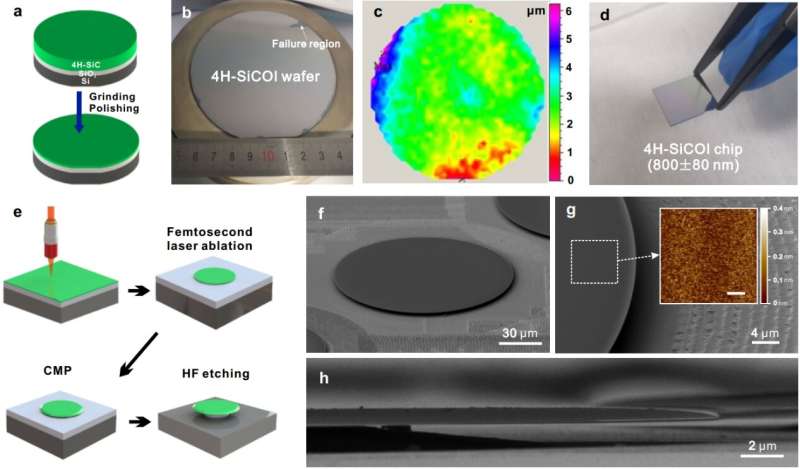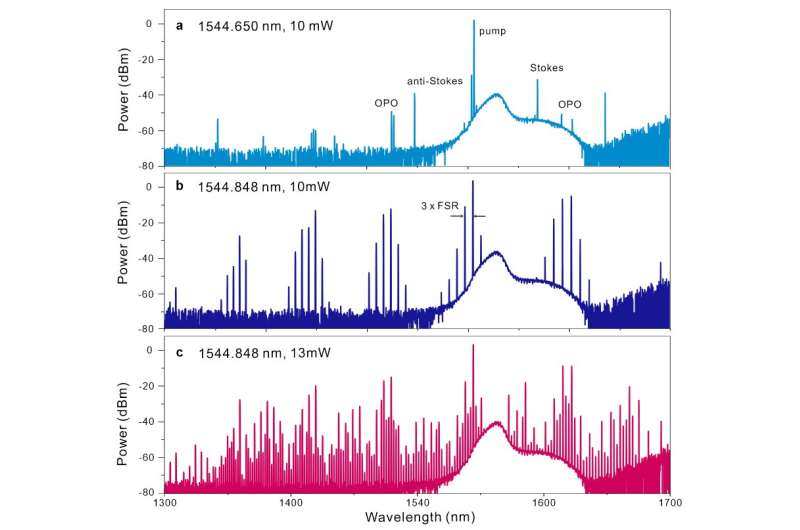A new platform for integrated photonics

SiC photonics has been developed for over a decade, one of the major obstacles is the difficulty of fabricating ultralow optical loss SiC thin-films. Scientists in China have fabricated an ultralow loss 4H-SiCOI platform with a record-high-Q factor of 7.1 × 106. Nonlinear photonics process, including second-, third- and fourth-harmonic generations, Raman lasing, and Kerr frequency combs have been observed. This demonstration represents a milestone in the development of SiC photonic devices.
Photonic integrated circuits (PICs) and microresonators have attracted strong interest in photonics community. For applications, achieving low optical loss is crucial. SiC PICs have been in development for over a decade, a lot of works have been carried out on the SiC thin films prepared by heteroepitaxial growth. However, the quality factor of these devices is limited to less than 106 due to the high density of crystal defects near growth interface. Up to now, how to further reduce the optical loss of SiC thin films has become the primary problem for scientist to explore the advantages of SiC in PICs applications.
In a new paper published in Light Science & Application, a team of scientists, led by Professor Xin Ou from State Key Laboratory of Functional Materials for Informatics, Shanghai Institute of Microsystem and Information Technology, Chinese Academy of Sciences, and co-workers have fabricated an ultralow loss 4H-SiCOI platform with a record-high-Q factor of 7.1 × 106. The 4H-SiCOI platform prepared by wafer-bonding than thinning techniques, enables the same crystalline quality as bulk high-pure 4H-SiC crystal. The high Q resonators were used to demonstrate various nonlinear processes including generation of multiple harmonics up to the fourth order, cascaded Raman lasing, and Kerr frequency comb. Broadband frequency conversions, including second-, third-, fourth- harmonic generation (SHG, THG, FHG) have been observed. Cascaded Raman lasing with Raman shift of 204.03 cm-1 has been demonstrated in SiC microresonators for the first time. Using a dispersion-engineered SiC microresonator, Kerr frequency combs covering from 1300 to 1700 nm have been achieved at a low input power of 13 mW.
The demonstration of high Q SiC photonics devices represents a significant milestone in the development of SiC PICs. This work was also highly praised by the reviewers. "In my opinion, this work is novel, sound and important. I believe this work will bring a huge momentum for SiC integrated photonics in the next few years", "I believe this work will be a milestone for SiC photonics", "The presented work here shows microresonator with Q up to 7.1 × 106, which is certainly a major breakthrough in the development of photonic devices that harness the unique optical properties of SiC".

More information: Chengli Wang et al, High-Q microresonators on 4H-silicon-carbide-on-insulator platform for nonlinear photonics, Light: Science & Applications (2021). DOI: 10.1038/s41377-021-00584-9
Journal information: Light: Science & Applications
Provided by Chinese Academy of Sciences




















